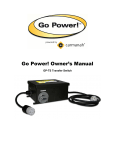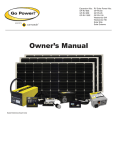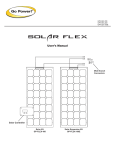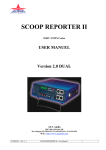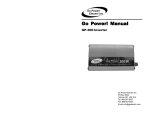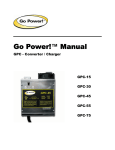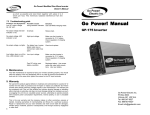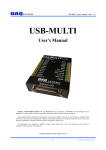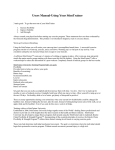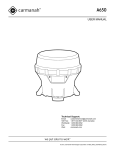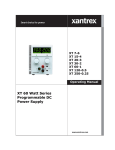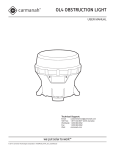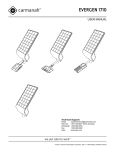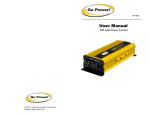Download User Manual
Transcript
GP-PWM-10 _________________________________________________________________________________ User Manual © 2015 Carmanah Technologies Corporation GP-PWM-10 _________________________________________________________________________________ 2 © 2015 Carmanah Technologies Corporation GP-PWM-10 _________________________________________________________________________________ Contents 1.0 Installation Overview 4 1.1 1.2 4 5 Introduction Specifications 2.0 Warnings 6 3.0 Tools and Materials Needed 6 4.0 Choosing a Location 7 5.0 Installation Instructions 7 6.0 Wiring Diagram 9 7.0 Operating Instructions 10 7.1 7.2 7.3 7.4 7.5 7.6 10 10 11 12 12 14 Power Up Setting the Battery Charging Profile Battery Charging Profile Chart Maximum Power Boost Technology™ Viewing the Controller Display Information Errors 8.0 Display Symbols 15 9.0 USB Charging 16 10.0 Frequently Asked Questions (FAQs) 17 11.0 Troubleshooting Problems 18 11.1 11.2 11.3 18 19 20 12.0 Problems with the Display Problems with Voltage Problems with Current Limited Warranty 22 12.1 22 Repair and Return Information 3 © 2015 Carmanah Technologies Corporation GP-PWM-10 _________________________________________________________________________________ 1.0 Installation Overview 1.1 Introduction A Solar Controller (or Charge Controller / Regulator) is an essential component of your photovoltaic solar system. The Controller maintains the life of the battery by protecting it from overcharging. When your battery has reached a 100% state of charge, the Controller prevents overcharging by limiting the current flowing into the batteries from your solar array. The GP-PWM-10 is a 12-volt photovoltaic (PV) charge controller rated for a continuous solar current input of 10 amps. The GP-PWM-10 uses Pulse Width Modulation (PWM) technology and a unique four stage charging system that includes an optional equalize setting to charge and protect your battery bank. The GP-PWM-10 features an LCD digital display that shows the charge current of the solar array, system battery voltage and battery capacity. The GP-PWM-10 also features Maximum Power Boost Technology™ for manual bulk charge at any stage of the charge cycle. 4 © 2015 Carmanah Technologies Corporation GP-PWM-10 _________________________________________________________________________________ 1.2 Specifications Description Value Dimensions (H x W x D): Nominal System Voltage 12V Max. Solar Array Current 10A (amperage is reduced above 50°C) Battery Voltage Range 100 x 102 x 29 mm 3.94 x 4.02 x 1.14 in Weight: 178 g / 6.3 oz 6V – 15.5V Maximum Wire Gauge: Max. Solar Voltage Operating Consumption 28V #4 AWG Warranty: 5 years 15mA (Display backlight on) PWM Charging Operating Consumption 6mA 3 Battery Charging 14.1/14.4/14.4V 4 Stage Charging (25°C / 77°F), 1 - 2h / Day Monthly Equalize (Display backlight off) Bulk/Absorption Voltage (Sealed/Gel, AGM, profiles option Flooded) Float Voltage 13.7V (25°C / 77°F) Equalization Voltage 14.9V (25°C / 77°F), 2h / 28 Day or V < 12.1 Temperature Compensation - 24mV/ºC / -13V/ºF Displays Charging Current, Battery Voltage and Battery State of Charge Reverse Polarity protected USB charger 5V, 800mA Operating Temperature - 40 to 85°C / - 40 to 185°F Display Operating - 10 to 55°C / - 14 to 131°F Temperature Compensated RoHS Compliant, environmentally safe Temperature Accepts up to 160 Humidity 99% N.C. Protection Battery Reverse Polarity, Solar Array Reverse Polarity, Over Temperature, PV Short Circuit, Over Current watts of solar at 12 volts Maximum Power Boost Technology The total rated Maximum Power Current (Imp) of the PV input should not exceed 10 amps. The GP-PWM-10 will limit PV current above 10 Amps. Although the GP-PWM-10 will accept PV current greater than 10 Amps for a short duration, damage may occur if the GP-PWM-10 operates continuously with greater than 10 Amps of PV input. 5 © 2015 Carmanah Technologies Corporation GP-PWM-10 _________________________________________________________________________________ 2.0 Warnings Disconnect all power sources Battery and wiring safety Wiring connections Work safely Observe correct polarity Do not exceed the GP-PWM-10 Amp current and max voltage ratings Electricity can be very dangerous. Installation should be performed only by a licensed electrician or qualified personnel. Observe all safety precautions of the battery manufacturer when handling or working around batteries. When charging, batteries produce hydrogen gas, which is highly explosive. Ensure all connections are tight and secure. Loose connections may generate sparks and heat. Be sure to check connections one week after installation to ensure they are still tight. Wear protective eyewear and appropriate clothing during installation. Use extreme caution when working with electricity and when handling and working around batteries. Reverse polarity of the battery terminals and array will cause the controller to give a warning tone. The controller will not function unless battery terminals are connected to a battery with proper polarity. Failure to correct this fault could damage the controller. The current rating of the solar system is the sum of the Maximum Power Current (Imp) of the solar PV strings in parallel. The resulting system Imp current is not to exceed 10A. The voltage of the array is the rated open circuit voltage (Voc) of the PV array and is not to exceed 28V. If your solar system exceeds these ratings, contact your dealer for a suitable controller alternative. 3.0 Tools and Materials Needed Flathead Screwdriver (for wire terminals) Philips Screwdriver (for mounting screws) If the GP-PWM-10 Controller was purchased with a Go Power! RV Solar Power Kit then UV resistant wire is included. For instructions regarding the Go Power! RV Solar Power Kit installation, please refer to the Installation Guide provided with the Kit. 6 © 2015 Carmanah Technologies Corporation GP-PWM-10 _________________________________________________________________________________ 4.0 Choosing a Location The GP-PWM-10 is designed to be mounted against a wall, out of the way but easily visible. The GP-PWM-10 should be: Mounted as close to the battery as possible Mounted on a vertical surface to optimize cooling of the unit Indoors, protected from the weather In an RV, the most common controller location is above the refrigerator. The wire from the solar array most commonly enters the RV through the fridge vent on the roof or by using the Go Power! Cable Entry Plate (sold separately) that allows installers to run wires through any part of the roof. PV connections should connect directly to the controller. Positive and negative battery connections must connect directly from the controller to the batteries. Use of a positive or negative distribution bus is allowed between the controller and battery as long as it is properly sized, electrically safe and an adequate wire size is maintained. 5.0 Installation Instructions 1. Complete the installation of the solar modules. If this GP-PWM-10 was purchased as part of a Go Power! Solar Power Kit, follow the Installation Guide provided. Otherwise, follow manufacturer’s instructions for solar module mounting and wiring. 2. Select wire type and gauge. If this GP-PWM-10 was purchased as part of a Go Power! Solar Power Kit, appropriate wire type, gauge and length is provided. Please continue to Section 6, “Operating Instructions.” If the GP-PWM-10 was purchased separately, follow the instructions included here. Wire type is recommended to be a stranded copper UV resistant wire. Wire fatigue and the likelihood of a loose connection are greatly reduced in stranded wire compared to solid wire. Wire gauge should be able to sustain rated current and minimize voltage drop. 7 © 2015 Carmanah Technologies Corporation GP-PWM-10 _________________________________________________________________________________ Wire Strip Gauge You will find a strip gauge diagram on the back of the GP-PWM-10, which helps you to strip your wires to the correct length. Insert wire into the concave slot of the strip gauge until it meets the back of the Strip Gauge slot. Mark the length of wire from the back of the Strip Gauge slot to the edge of the controller with a pen or your finger and strip all wires to be connected to the controller to this length. Suggested Minimum Wire Gauge (Cable length 25 ft. max. from solar array to battery bank) 50 Watt Solar Module 80 Watt Solar Module 95 Watt Solar Module 110 Watt Solar Module 125 Watt Solar Module 160 Watt Solar Module 240 Watt Solar Module Terminal Screw Torque #14 Wire Gauge #12 Wire Gauge #10 Wire Gauge #10 Wire Gauge #10 Wire Gauge #10 Wire Gauge #10 Wire Gauge 16 inch pounds (1.8N.m) IMPORTANT: Identify the polarity (positive and negative) on the cable used for the battery and solar module. Use colored wires or mark the wire ends with tags. Although the GP-PWM-10 is protected, a reverse polarity contact may damage the unit. Wiring the GP-PWM-10. Wire the GP-PWM-10 according to the wiring schematic in Section 6. Run wires from the solar array and the batteries to the location of the GP-PWM-10. Keep the solar array covered with an opaque material until all wiring is completed. 3. Torque all terminal screws to 16 inch pounds (1.8N.m). Connect the battery wiring to the controller first and then connect the battery wiring to the battery. IMPORTANT: Always use appropriate circuit protection on any conductor attached to a battery. 8 © 2015 Carmanah Technologies Corporation GP-PWM-10 _________________________________________________________________________________ With battery power attached, the controller should power up and display information. Connect the solar wiring to the controller and remove the opaque material from the solar array. The negative solar array and battery wiring must be connected directly to the controller for proper operation. Do not connect the negative solar array or negative battery controller wiring to the chassis of the vehicle. 4. Mounting the GP-PWM-10. Mount the GP-PWM-10 to the wall using the included four mounting screws. IMPORTANT: You must set the battery type on the GP-PWM-10 before you begin to use the controller (follow steps in Section 7). The default battery setting is for AGM batteries. Congratulations, your GP-PWM-10 should now be operational. If the battery power is low and the solar array is producing power, your battery should begin to charge. 5. Re-torque: After 30 days of operation, re-torque all terminal screws to ensure the wires are properly secured to the controller. 6.0 Wiring Diagram The GP-PWM-10 is based on a 10 amp max input from the solar modules. Use the wiring diagram to connect your battery to the battery terminals on the solar controller. First, connect the battery to the controller and then connect the solar panel to the controller. The fuse or breaker used should be no larger than 10 amps. The controller will not work unless there is a battery connected to the battery terminals. 9 © 2015 Carmanah Technologies Corporation GP-PWM-10 _________________________________________________________________________________ 7.0 Operating Instructions 7.1 Power Up When the GP-PWM-10 is connected to the battery, the controller will go into Power Up mode. Icons Displayed: All segments of the numerical display; Backlight blinks Depending on the battery voltage when the GP-PWM10 Power Up occurs, the controller may do a Boost Charge or quickly go into Float Charge. The Charging Profile selected will commence the following day after a Power Up (refer to the Charging Profile Chart on page 11 for more details). 7.2 Setting the Battery Charging Profile To select the battery charging profile, press and hold the B Button. This will cause the current battery type to flash. Then, press the B Button to toggle through the profile options: Sealed/Gel, AGM or Flooded. 10 © 2015 Carmanah Technologies Corporation GP-PWM-10 _________________________________________________________________________________ To confirm the battery profile, press and hold the A Button for 3 seconds. Non-volatile memory: Any settings made on the GPPWM-10 will be saved even when the power has been disconnected from the controller. Refer to the Battery Charge Profile Chart below for details on each profile. 7.3 Battery Charging Profile Chart Battery Type SEALED /GEL Float Charge @ 25°C: AGM FLOODED 13.7V (+/- 0.1V) Bulk/Absorption Charge @ 25°C: Set to 30 minutes every morning. Applied for 1 hour if the battery voltage drops below 12.3 volts. Equalization Charge: Applied for 2 hours every 28 days and if the battery voltage drops below 12.1 volts. 14.1V (+/- 0.1V) 14.4V (+/- 0.1V) 14.4V (+/- 0.1V) N/A N/A 14.8V (+/-0.1V) If a charging cycle is unable to complete in a single day, it will continue the following day. The terms SEALED/GEL, AGM and FLOODED are generic battery designations. Choose the charging profile that works best with your battery manufacturer’s recommendations. Auto Equalize: The GP-PWM-10 has an automatic equalize feature that will charge and recondition your batteries once a month at a higher voltage to ensure that any excess sulfation is removed. This feature is only available when Flooded batteries are selected. 11 © 2015 Carmanah Technologies Corporation GP-PWM-10 _________________________________________________________________________________ 7.4 Maximum Power Boost Technology™ Maximum Power Boost Technology™ (MPBT) allows you to override the normal charging algorithm of the solar controller. MPBT is designed to be used before the end of the day, if you know you will require many loads through the night. This feature can also be used when you have just installed the solar controller, to put batteries on a boost charge up to 14.4 (Flooded and AGM) (14.1 for Sealed/Gel) right away. To activate, hold the MAX BOOST Button for 3 seconds. As long as there is full sunlight present, your battery voltage will be boosted (to 14.4V for Flooded and AGM and 14.1V for SEALED/GEL) for 30 minutes regardless of the battery’s state of charge. Icons Displayed: BOOST; Battery Symbol IMPORTANT: Do not use the Maximum Power Boost function more than twice a day as it could damage your batteries due to gassing. 7.5 Viewing the Controller Display Information To toggle between Battery Voltage, PV Charging Current and Battery State of Charge (SOC), press the B Button. Push the B Button to show the battery voltage. Icons Displayed: Battery SOC, Volt Symbol (V) 12 © 2015 Carmanah Technologies Corporation GP-PWM-10 _________________________________________________________________________________ Push the B Button to show the PV charging current. Icons Displayed: Arrow, Ampere Symbol (A), Battery SOC Push the B Button to show the battery state of charge (shown as a percentage). Icons Displayed: Battery SOC, Percent Symbol (%) 13 © 2015 Carmanah Technologies Corporation GP-PWM-10 _________________________________________________________________________________ 7.6 Errors Over Voltage If the GP-PWM-10 experiences a battery over voltage (15.5V), the controller will stop operating and the display will begin to flash with all icons. The controller will resume operating when the error is cleared. Icons Displayed: All symbols Low Voltage If the battery state of charge reaches 0%, the battery SOC symbol will show the text “LOW” beneath it. The controller will continue operating in this condition and will only stop operating if the voltage drops below 6 volts. Icons Displayed: Battery SOC Symbol, LOW 14 © 2015 Carmanah Technologies Corporation GP-PWM-10 _________________________________________________________________________________ 8.0 Display Symbols Symbol Indicator For: Battery 1 Day Time: PV Charge Current Night Time Battery Voltage Battery State of Charge SEALED AGM FLOODED Sealed/Gel AGM Flooded Other Symbols USB charger on (When charger is off, no symbol will show) BOOST LOW Whole display will start to blink Controller tries to keep battery at Boost Voltage or higher Battery voltage is lower than 11.0V Battery voltage > 15.5V 15 © 2015 Carmanah Technologies Corporation GP-PWM-10 _________________________________________________________________________________ Battery State of Charge Symbol Battery Voltage Shows only after full Boost or Equalization Cycle >= 12.6V >= 11.8 -12.6V > 11.0 -11.8V <= 11.0V 𝑆𝑂𝐶 = 100% Shows only after full Boost or Equalization Cycle 90% >= 12.8V 𝑏𝑎𝑡𝑡𝑒𝑟𝑦 𝑣𝑜𝑙𝑡𝑎𝑔𝑒 − 11.0𝑉 ∗ 90% 1.8𝑉 0% 9.0 < 12.8V and > 11.0V <= 11.0V USB Charging The GP-PWM-10 offers a standard USB connector for delivering 5V to small mobile appliances such as cell phones, tablets, small music players. This charging port is capable of supplying up to 800 mA of current. The USB charging port is always active when the USB symbol appears on the display. 16 © 2015 Carmanah Technologies Corporation GP-PWM-10 _________________________________________________________________________________ The controller disables the USB charger automatically if the battery voltage drops below 11.0V. If there is enough current from the PV panel/array available to charge the Battery to above 12.8V, the USB terminal will be enabled again. Warning: Do not connect the charging device anywhere else! USB-Negative contact is connected to battery negative. 10.0 Frequently Asked Questions (FAQs) Before a problem is suspected with the system, read this section. There are numerous events that may appear as problems but are in fact perfectly normal. Please visit gpelectric.com for the most up-to-date FAQs. It seems like my flooded batteries are losing water over time. Flooded batteries may need to have distilled water added periodically to replace fluid loss during charging. Excessive water loss during a short period of time indicates the possibility of overcharging or aging batteries. When charging, my flooded batteries are emitting gas. During charging, hydrogen gas is generated within the battery. The gas bubbles stir the battery acid allowing it to receive a more full state of charge. Important: Ensure batteries are in a well-ventilated space. My voltmeter shows a different reading than the GP-PWM-10 display The meter value on the GP-PWM-10 display is an approximate reading intended for indication purposes only. There is an approximate 0.1 volt inherent error present that may be accentuated when compared with readings from another voltmeter. 17 © 2015 Carmanah Technologies Corporation GP-PWM-10 _________________________________________________________________________________ There may be a slight difference between the battery voltage displayed on the GP-PWM-10 display and the battery voltage measured at the battery terminals. When troubleshooting using a voltmeter, check both the battery voltage at the GP-PWM-10 controller terminals and battery voltage at the battery terminals. If a difference of more than 0.5 volts is noted, this indicates a large voltage drop possibly caused by loose connections, long wire runs, small wire gauge, faulty wiring, a faulty voltmeter or all the above. Consult the Suggested Minimum Wire Gauge chart in Section 5 for wiring suggestions and check all connections. 11.0 Troubleshooting Problems How to Read this Section Troubleshooting Problems is split into three sub-sections, grouped by symptoms involving key components. Components considered irrelevant in a diagnosis are denoted ‘Not Applicable’ (N/A). A multimeter or voltmeter may be required for some procedures listed. It is imperative all electrical precautions stated in the Warning Section and outlined in the Installation Section are followed. Even if it appears the system is not functioning, it should be treated as a fully functioning system generating live power. 11.1 Problems with the Display Display Reading: Blank Time of Day: Daytime/Nighttime Possible Causes: Battery or fuse connection and/or solar array connection (Daytime only) or battery or fuse connection (Nighttime only). How to tell: 1. Check the voltage at the controller battery terminals with a voltmeter and compare with a voltage reading at the battery terminals. 2. If there is no voltage reading at the controller battery terminals, the problem is in the wiring between the battery and the controller. If the battery voltage is lower than 6 volts the controller will not function. 18 © 2015 Carmanah Technologies Corporation GP-PWM-10 _________________________________________________________________________________ 3. For the solar array, repeat steps 1 and 2 substituting all battery terminals with solar array terminals. Remedy: Check all connections from the controller to the battery including checking for correct wire polarity. Check that all connections are clean, tight, and secure. Ensure the battery voltage is above 6 volts. Display Reading: Nighttime Time of Day: Daytime Possible Causes: Panel is covered by something; PV panel is too dirty to supply a high enough voltage to charge the battery; PV panel is not connected. Remedy: Check the panel and to ensure it is not obscured. Clean the panel if it is dirty. Check that PV cables are connected to the controller. 11.2 Problems with Voltage Voltage Reading: Inaccurate Time of Day: Daytime/Nighttime Possible Cause: Excessive voltage drop from batteries to controller due to loose connections, small wire gauge or both. How to tell: 1. Check the voltage at the controller battery terminals with a voltmeter and compare with the voltage reading at the battery terminals. 2. If there is a voltage discrepancy of more than 0.5 V, there is an excessive voltage drop. Remedy: Check all connections from the controller to the battery including checking for correct wire polarity. Check that all connections are clean, 19 © 2015 Carmanah Technologies Corporation GP-PWM-10 _________________________________________________________________________________ tight, and secure. Shorten the distance from the controller to battery or obtain larger gauge wire. It is also possible to double up the existing gauge wire (i.e. two wire runs) to simulate a larger gauge wire. 11.3 Problems with Current Current Reading: 0 A Time of Day: Daytime, clear sunny skies Possible Cause: Current is being limited below 1 Amp as per normal operation or poor connection between solar array and controller. How to tell: 1. The State of Charge (SOC) screen is close to 100% and the Sun and Battery icon are present with an arrow between. 2. With the solar array in sunlight, check the voltage at the controller solar array terminals with a voltmeter. 3. If there is no reading at the controller solar array terminals, the problem is somewhere in the wiring from the solar array to the controller. Remedy: 1. Hold down the MAX BOOST Button for approximately 3 seconds to activate Maximum Power Boost. This will allow the controller to charge batteries to 14.4 +/- 0.1V (14.4 +/- 0.1V Sealed/Gel) with all current the solar array is producing. 2. Check all connections from the controller to the array including checking for correct wire polarity. Check that all connections are clean, tight, and secure. Continue with the solutions below for additional help on low current readings. Current Reading: Less than expected Time of Day: Daytime, clear sunny skies Possible Causes: (1) Current is being limited below 1 Amp as per normal operation. 20 © 2015 Carmanah Technologies Corporation GP-PWM-10 _________________________________________________________________________________ (2) Incorrect series/parallel configuration and/or wiring connections and/or wire gauge. (3) Dirty or shaded module or lack of sun. (4) Blown diode in solar module when two or more modules are connected in parallel. How to tell: (1) Battery State of Charge screen is close to 100% and the Sun and Battery icon are present with an arrow in between. (2) Check that the modules and batteries are configured correctly. Check all wiring connections. (3) Modules look dirty, overhead object is shading modules or it is an overcast day in which a shadow cannot be cast. Avoid any shading no matter how small. An object as small as a broomstick held across the solar module may cause the power output to be reduced. Overcast days may also cut the power output of the module. (4) Disconnect one or both array wires from the controller. Take a voltage reading between the positive and negative array wire. A single 12 volt module should have an open circuit voltage between 17 and 22 volts. If you have more than one solar module, you will need to conduct this test between the positive and negative terminals of each module junction box with either the positive or the negative wires disconnected from the terminal. Remedy: (2) Reconnect in correct configuration. Tighten all connections. Check wire gauge and length of wire run. Refer to Suggested Minimum Wire Gauge in Section 5. (3) Clean modules, clear obstruction or wait for conditions to clear. (4) If the open circuit voltage of a non-connected 12 volt module is lower than the manufacturer’s specifications, the module may be faulty. Check for blown diodes in the solar module junction box, which may be shorting the power output of module. 21 © 2015 Carmanah Technologies Corporation GP-PWM-10 _________________________________________________________________________________ 12.0 Limited Warranty 1. Carmanah warrants the GP-PWM-10 for a period of one (1) year from the date of shipment from its factory. This warranty is valid against defects in materials and workmanship for the one (1) year warranty period. It is not valid against defects resulting from, but not limited to: Misuse and/or abuse, neglect or accident Exceeding the unit’s design limits Improper installation, including, but not limited to, improper environmental protection and improper hook-up Acts of God, including lightning, floods, earthquakes, fire, and high winds Damage in handling, including damage encountered during shipment 2. This warranty shall be considered void if the warranted product is in any way opened or altered. The warranty will be void if any eyelet, rivets, or other fasteners used to seal the unit are removed or altered, or if the unit’s serial number is in any way removed, altered, replaced, defaced, or rendered illegible. 12.1 Repair and Return Information Visit www.gpelectric.com to read the “frequently asked questions” section of our website to troubleshoot the problem. If trouble persists: 1. Call your Go Power!® Technical Support team (1-866-247-6527). 2. Return defective product to place of purchase 22 © 2015 Carmanah Technologies Corporation GP-PWM-10 _________________________________________________________________________________ 23 © 2015 Carmanah Technologies Corporation GP-PWM-10 _________________________________________________________________________________ © 2015 GO POWER!® By Carmanah Technologies MOBI_MAN_GP-PWM-10_vC gpelectric.com 24 © 2015 Carmanah Technologies Corporation
























